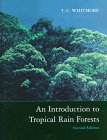An introduction to tropical rain forests/ T.C. Whitmore
Material type: TextPublication details: Oxford: Oxford University Press, 2003Edition: 2nd edDescription: xiii, 282 p. : ill. ; 25 cmISBN: 9780198501480Subject(s): Rain forest ecology | Rain forestsDDC classification: 333.75
TextPublication details: Oxford: Oxford University Press, 2003Edition: 2nd edDescription: xiii, 282 p. : ill. ; 25 cmISBN: 9780198501480Subject(s): Rain forest ecology | Rain forestsDDC classification: 333.75 | Item type | Current library | Call number | Status | Date due | Barcode | Item holds |
|---|---|---|---|---|---|---|
|
|
Central Library, Sikkim University General Book Section | 333.75 WHI/A (Browse shelf(Opens below)) | Available | P03515 |
Browsing Central Library, Sikkim University shelves, Shelving location: General Book Section Close shelf browser (Hides shelf browser)
1. An introduction to tropical rain forests
2. What are tropical rain forests?
2.1. Tropical moist forests and their climates
2.2. The forest formations
2.3. Forest maintenance - the growth cycle
2.4. Floristics
2.5. Nature of the tropical rain forest community
2.6. What are tropical rain forests? - Chapter summary
3. Plant life
3.1. Climbers and epiphytes
3.2. Trees
3.3. Seasonal rhythms
3.4. Plant life - Chapter summary
4. Rain forest animals
4.1. Richness and diversity of animals
4.2. Modes of coexistence
4.3. Carrying capacity of the forest
4.4. Rain forest animals - Chapter summary
5. Interconnections between plants and animals - the web of life
5.1. Animals as pollinators
5.2. Animals as dispensers
5.3. Food webs, mobile links, and keystone species
5.4. Co-evolution
5.5. Implications for forest conservation
5.6. Plant breeding systems
5.7. Interconnections between plants and animals - the web of life - Chapter summary
6. Tropical rain forests through time
6.1. Palaeogeography
6.2. Palaeoclimates
6.3. Pleistocene refugia
6.4. Seasonal climate elements in Malesia
6.5. High mountain plants
6.6. Conservation
6.7. Tropical rain forests through time - Chapter summary
7. Forest dynamics
7.1. Forest microclimates
7.2. Pioneer and climax tree species
7.3. Seed and seedling ecology
7.4. Components of species richness
7.5. Growth and shade tolerance
7.6. Silviculture
7.7. Growth rates and longevity
7.8. Community-wide disturbances
7.9. Forest recovery after human disturbance
7.10. The dynamics of climax rain forest
7.11. Forest dynamics - Chapter summary
8. Nutrients and their cycles
8.1. Shifting agriculture
8.2. Nutrient pools and cycles in primary rain forest
8.3. Practical implications
8.4. Heath forest - a fragile ecosystem
8.5. The upper montane forest enigma
8.6. Nutrients and their cycles - Chapter summary
9. Species richness
10. Tropical rain forests yesterday and today
10.1. Indigenous cultures
10.2. The colonial era
10.3. Minor forest products
10.4. Tropical rain forests in modern times
10.5. Forest conversion to other land usages
10.6. Logging and the timber trade
10.7. Animals in logged forest
10.8. Rates of disappearance
10.9. Controlling human impact
10.10. Causes for concern
10.11. Tropical rain forests yesterday and today - Chapter summary
11. Tropical rain forests at the cusp of the new millennium
11.1. Management for sustainability
11.2. Forest certification
11.3. The future pattern of land usage
11.4. Priorities for action
11.5. Tropical rain forests at the cusp of the new millennium - Chapter summary








There are no comments on this title.